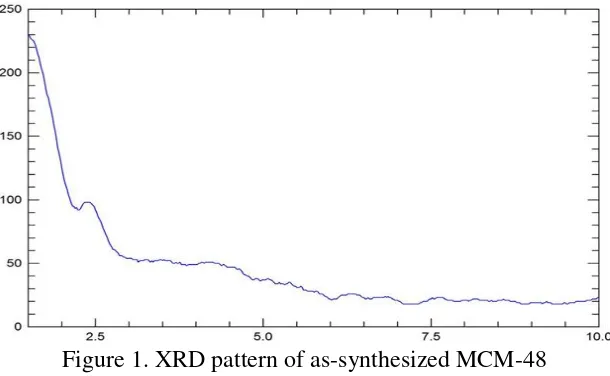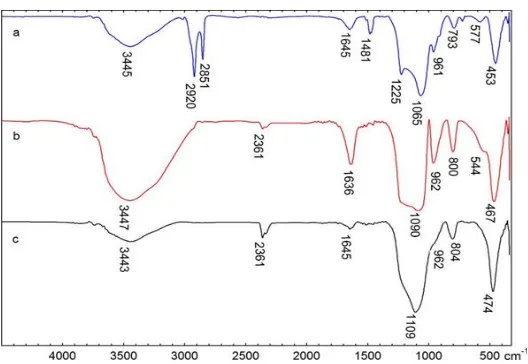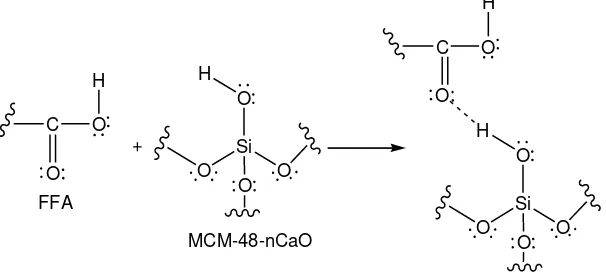1 THE USE OF MCM-48-nCaO AS CATALYST IN ESTERIFICATION REACTION
OF NYAMPLUNG SEED OIL (Calophyllum inophyllum L.)
La Kolo1, Firdaus, Paulina Taba
Chemistry Department, The Faculty of Maths and Natural Sciences, Hasanuddin University, Makassar, 90224
Abstrak. Penelitian penggunaan MCM-48-nCaO sebagai katalis pada reaksi esterifikasi minyak biji nyamplung (Calophyllum inophyllum L.) telah dilakukan. Hasil karakterisasi XRF, XRD, dan FTIR menunjukkan keberhasilan dalam proses sintesis katalis heterogen MCM-48-nCaO dengan menggunakan metode grinding-impregnasi. Melalui reaksi esterifikasi menggunakan katalis ini kadar FFA yang terkandung di dalam minyak biji nyamplung berkurang dari 28% menjadi 1,7%.
Kata Kunci : minyak biji nyamplung, MCM-48-nCaO, esterifikasi.
Abstract. A study on the use of MCM-48-nCaO as a catalyst in the esterification reaction of nyamplung seed oil (Calophyllum inophyllum L.) has been carried out. The characterization results of XRF, XRD and FTIR showed the success in the synthesis of heterogeneous catalysts, MCM-48-nCaO, using a grinding-impregnation method. Through esterification reaction using the catalysts, FFA content in the seed oil of nyamplung reduced from 28 to 1.7%.
Keywords: nyamplung seed oil, MCM-48-nCaO, esterification.
1
2 I. Introduction
Excessive and prolonged exploitation of crude oil causes the continuous decrease of oil resources [1]. Therefore, researches on seeking, optimizing and using alternative energy resources become a very important matter. One alternative renewable energy resource is biodiesel [2] Biodiesel can be obtained from foodstuffs. However, the use of the sources will compete with human food needs. As a consequence, non-foodstuffs sources, such as nyamplung seeds are required.
One of the factors that influence the acquisition of biodiesel is the content of free fatty acids or free fatty acid (FFA) present esterification reaction by using a strong acid catalyst [1]. FFA levels of nyamplung seed oil was lowered through esterification reactions using homogeneous catalysts, such as, H2SO4 and HCl [3.4]. Although this method gives good results, the use of homogeneous catalysts in the esterification reaction has several weaknesses, e.g. it is difficult to separate the catalysts from the product, they can create pollution to the environment, and the method is not economical [5.6]. In order to solve the problem, heterogeneous catalysts are utilized. Enggawati and Ediati [2] reported the use of CaO supported in fly ash as a catalyst in producing biodiesel from nyamplung seed oil. However, the rendamen
of biodiesel was just about 48.75%. Lee et al. [7] reported that the use of Al-MCM-41 in the esterification reaction can lower FFA levels of nyamplung seed oil from 21.4 to 0.7%. MCM-48 is a heterogeneous catalyst that is more effective in reducing the concentration of FFA vegetable oil compared to MCM-41[8]. It seems that the use of heterogeneous catalysts of MCM-48 in the esterification reaction gives a better expectation.
3 2. Materials
The materials used in this study were the seed of nyamplung taken from Kalauli Village, Leihitu District of Maluku province, n-hexane pa (E. Merck),
Aldrich, cetyltrimethyl ammonium bromide (CTAB) were obtained from Sigma Aldrich, Triton X-I00 (Sigma Aldrich), CH3COOH
1. Isolation Nyamplung Seed Oil
Isolation of nyamplung seed oil were conducted according to the procedure of Pamata [10] and Rokua [11]. Dry powder of nyamplung seed as many as 133.3 g was wrapped in a filter paper and at the seed was covered with cotton. The wrapped sample was placed in a Soxhlet extraction apparatus. Furthermore, n-hexane as many as 60 % of the volume of the extraction flask was put in the flask. The sample was extracted at a temperature of 70 °C until the liquid came out from the Soxhlet turning clear or colorless. The extract obtained was then poured into the Erlenmeyer, added with anhydrous Na2SO4. The Erlenmeyer was covered with a filter paper and stored
for 12 hours. Subsequently, the mixture was filtered and the solvent was evaporated using a rotary evaporator.
2. Degumming
A degumming process of nyamplung seed oil was conducted using the procedure of Mustafa and Purwanti [7], and Enggawati and Ediati [2]. Nyamplung oil was heated at a temperature of 65 °C, 5 % (v/v) of 85% phosphoric acid was then added into the oil, and stirred for 1 hour. Subsequently, the mixture was allowed to stand for 12 hours, and decanted. Oil obtained from the degumming was then washed with hot water (60-80 °C) until the pH of the waste water from the washing process was neutral. The neutral oil was then dried with anhydrous Na2SO4 and allowed to stand for 12 hours at room temperature. Furthermore, the mixture was filtered with a paper filter through a Buchner funnel.
3. Synthesis of MCM-48
4 mesophases were formed. To avoid
separation of the mesophases at an early stage of heating, the bottle containing the mixture was sometimes agitated. The reaction mixture was then cooled to room temperature and acetic acid (30 wt %) was added subsequently into the mixture in order to adjust the pH to 10. After the pH adjustment, the mixture was heated again at 100oC for 24 h and cooled to room temperature. As-synthesized MCM-48 was then filtered, washed with doubly distilled water and dried at 393 K in an oven. The surfactant was removed from the white product by washing with HCl-ethanol mixture until the surfactant left as small as possible
4. Synthesis of MCM-48-nCaO
Synthesis of MCM-48-nCaO was conducted according to the procedure of Albuquerque [13], Pouretedal and Ahmadi [14], and Pouretedal and Saedi [15]. A total number of n % w/w CaO (n = 14 and 20) to process being completed, the resulting catalyst was stored in a desiccator to maintain the catalyst remains dry. The catalyst obtained was then characterized by FTIR, XRD, and XRF.
5. Determination of Levels of FFA
The FFA content in the seed oil was determined according to the procedure of Enggawati and Ediati [2]. The nyamplung seed oil as many as 2 g was dissolved in 25
mL of hot isopropanol that had been previously neutralized with NaOH. Then, 2 drops of the PP indicator were added to the solution and the solution was titrated with
Esterification of nyamplung seed oil was performed according to the procedure of Albuquerque et. al. [16], Kartika and Widyaningsih [17], and Enggawati and Ediati [2]. Nyamplung oil esterification was conducted in a 500 mL three neck flask equipped with an electric heater, a thermometer, a magnetic stirrer, and a cooling system. The reaction temperature was maintained at 60 °C with a stirring rate of 1200 rpm, the catalyst molar ratio to methanol of 2% (w/w), the oil molar ratio to methanol of 1: 9 and a reaction time of 60 minutes. The reaction was stopped by immersing the three neck flask in an ice bath. Furthermore, the mixture was filtered through a Buchner funnel using a filter paper. The percentage of FFA in the results obtained was then calculated. The esterification reaction was done to obtain the oil of nyamplung seed with the FFA content of < 2 %.
III. Results and Discussion 1. Isolation Nyamplung Seed Oil
5 an extract of 67.79 % (90.37 g) from 133.3
g of the fine powder of nyamplung seed. The result obtained was in the form of a clear yellow liquid with a specific smell of nyamplung seed oil.
2. Degumming
The degumming process using H3PO4 produced 9.32 g latex and 80.07 g of pure nyamplung oil. The Nyamplung pure oil was obtained in the form of brownish yellow liquid with a specific smell of nyamplung seed oil.
3. Characterization of MCM-48 and Catalysts Heterogeneous
MCM-48-nCaO
The success of the synthesis of MCM-48 can be seen from the results of characterization using XRD. X-ray diffraction pattern of MCM-48 is shown in Figure 1. X-ray diffraction pattern of MCM-48 showed peaks at 2.4° 2 theta and several peaks with low intensity.
Figure 1. XRD pattern of as-synthesized MCM-48
The X-ray diffraction pattern of MCM-48 showed a strong peak at 2 theta of 2.54o and seven other peaks with low intensity [18]. In this study, peaks appear at the diffractogram has an intensity that is much lower than that obtained in previous studies and some of the peaks are not clearly visible. This happens because in this study, the measurement was conducted at 2 theta of 1.5 to 10o whereas in the previous
studies, the measurement was performed at 2 theta of 0.8 to 10o.
6 Figure 2. FTIR spectra of a) MCM-48 before washing, b) MCM-48 after washing, and c)
MCM-48-20CaO
Two specific areas for organic molecules derived from the surfactant (cetyltrimethyl ammonium bromide) was observed in the spectrum of MCM-48 before washing (Figure 2a); CH stretching (between 2800 cm-1 and 3010 cm-1) and CH bending, (between 1300 cm-1 and 1500 cm -1
). A broad peak at 3445 cm-1 and a peak at 1645 cm-1 are also observed. These peaks are the contribution of silanol and water physically adsorbed by MCM-48. A strong peak at 1225 cm-1 and 1065 cm-1 and weak peaks at 961 cm-1 and 793 cm-1 can be assigned to the Si-O stretching vibration of the silicate lattice. After washing with HCI-ethanol 3 times (Figure 2b) peaks, the peaks of C-H stretching and bending almost disappear. This indicates that most of the surfactant has been lost. This is supported by the shift of peaks at 1225 cm-1 and 1065 cm-1 to larger wave numbers. The peak shift occurs due to lattice contraction during template (surfactant) removal as has been reported in previous studies [12.14.15].
Figure 2c is a FTIR spectrum of MCM-48-20CaO. There is a decline in the intensity of the peaks at wavenumbers of
962 cm-1, 3447 cm-1, and 1636 cm-1. It is caused by the reaction of CaO with silanol groups on the MCM-48 [19.20]. The decrease in the intensity occurred due to a change of Si-O-H into Si-O-Ca bonds [21.22]. At a high temperature, CaO can react with Si-OH of MCM-48 to form CaSiO3 or CaSiO4 [23]. The assumption is also supported by the shift of a peak at a wavenumber of 1090 cm-1 (Figure 2b) to that of 1109 cm-1 (Figure 2c). The peaks belong to the asymmetrical stretching vibration of Si-O and Si-O-Si, respectively.
7 results of characterization using FTIR method (Figure 2c).
Table 1. Characterization results of MCM-48-nCaO materials using XRF
No. Catalyst Ratio (%-w/w) XRF (%-w/w)
MCM-48 Ca(CH3COO)2.H2O SiO2 CaO
1. MCM-48-14CaO 86 14 92.69 7.25
2. MCM-48-20CaO 80 20 89.54 10.19
1. FFA Content of Nyamplung Seed Oil
The FFA content in nyamplung seed oil before and after esterification reaction (twice) is presented in Table 2.
Table 2. FFA content of nyamplung seed oil before and after esterification process
No. Reaction Catalysts FFA
(%) Rendamen (%)
1. Before esterification - 28 -
2. First esterification MCM-48-20CaO 9 95.12
3. Second esterification MCM-48-14CaO 1.7 87.59
The first esterification process lowers the FFA of nyamplung seed oil from 28 to 9 % whereas the second process lower it from 9 to 1.7 %. The esterification results show that the heterogeneous catalysts of MCM-48-14CaO and MCM-48-20CaO have the
ability to reduce the FFA content. This is caused by presence of silanol groups in MCM-48. The silanol groups can interact with C=O groups of FFA via the hydrogen bond [24] as can be seen in Figure 3.
C O
O H
FFA
O Si
O O
O H
O Si
O O
O H
MCM-48-nCaO
C O
O H
Figure 3. Interaction of silanol groups in with FFA
In addition, the presence of Ca also affects the activity of heterogeneous
8 caused by the increase of the Lewis acid of
MCM-48 after the presence of Ca in the framework [25.26].
IV. Conclusion
Heterogeneous catalysts of MCM-48-nCaO was able to lower FFA levels contained in the oil of nyamplung seed from 28 to 9 % and from 9 to 1.7 % after the first and second esterification processes, respectively.
Acknowledgements
The author would like to thank the Foundation of Kharisul Khairat Tidore which has provided research funds for this work.
References
1. Permatasari A., Mayangsari, W. and Gunardi, I. (2013). Biodiesel from oil Nyamplung (Calophyllum inophyllum L.) by transesterification reaction catalyst Using K2O/H-Za Based Natural Zeolite. J. Eng. POMITS, 2 (2) : 290-295.
2. Enggawati E. R., and Ediati R. (2013). Utilization Skin Chicken Eggs and Coal Fly Ash as Heterogeneous Catalysts for transesterification reactions Nyamplung Oil (Calophyllum inophyllum L.). J. Sci. Art. POMITS, 2 (1) : 1-6.
3. Setiawati E., and Edwar F. (2012). Biodiesel Processing Technology of Cooking Oil with Microfiltration Technique and transesterification as Alternative Fuel Diesel Engine. J. Ind. Res., 6 (2) : 117-127.
4. Christina N., Sungadi E., Hindarso H., and Kurniawan Y. (2013) Biodiesel
from oil Nyamplung Using Calcium-Based Catalysts. J. Sci. Wid. Eng., 12 (2) : 26-35.
5. Santoso H., Kristianto I., and Setyadi A. (2013). Biodiesel Using Heterogeneous Catalysts Bases Made Basic Skin eggs. Leading research universities. Bandung: Institute for Research and Community Service. Universitas Katolik Prahayangan. 6. Carmo J. A.C., Souza D. L. K. C.,
Costa D. C. E. F., Longo E., Zamian J. R., and Rocha D. F. G. N. (2009). Production of Biodiesel by Esterification of Palmitic Acido Over Mesoporous Aluminosilicate Al-MCM-41. Fuel, 88 : 461-468.
7. Mustafa B., and Purwanti E. S. (2011). Biodiesel heat Results catalyst esterification with Al-MCM-41 and Transesterification with Potassium Hydroxide Catalyst Nyamplung Seed Oil (Calophyllum inophyllum L.), Proceedings of the Chemistry-ITS, SK-091304, 1-8.
8. Lee A. F., Bennett J. A., Manayil J. C., and Wilson K. (2014). Heterogeneous Catalysis for Sustainable Biodiesel Production via Esterification and Transesterification. Chem. Soc. Rev., 43 : 7887-7916.
9. Singh S., and Patel A. (2014). 12-Tungstophosphoric Acid Supported on Mesoporous Molecular Material : Synthesis, Characterization and Performance in Biodiesel Production. J. Clean. Prod., 72 : 46-56.
9 Extraction through Ultrasonokimia
method. Skripsi. Depok : Department of Chemistry. University of Indonesia. 11. Rokua H. (2012). Component Analysis
of Fatty Acid Undur Undur Sea (Emerita sp.) From the village of Hila Water Central Maluku district. Skripsi. Ambon : Education Program Chemistry. Faculty of Teacher Training and Education. University of Pattimura. 12. Taba P. (2008). Adsorption of Water
and Benzene Vapour in Mesoporous Materials. MAKARA, 12 (2) : 120-125. 13. Albuquerque M. C. G. (2008).
Synthesis, characterization and application of heterogeneous catalysts for the production of biofuels. Dissertation. Fortaleza : Post-Graduation Program in chemistry. Federal University of Ceara.
14. Pouretedal H. R., and Saedi E. (2014). Dechlorination of 2,4-Dichlorophenol by Zero-Valent Iron Nanoparticles Impregnated MCM-48. Int. J. Ind. Chem., 5 : 77-83.
15. Pouretedal H. R., and Ahmadi M. (2012). Synthesis, Characterization, and Photocatalytic Activity of MCM-41 and MCM-48 Impregnated with CeO2 Nanoparticles. Nano Lett., 2 (10) : 1-8.
16. Albuquerque M. C. G., Urbistondo I. J., Gonzalez J. S., Robles J. M. M., Tost R. M., Castellon E. R., Lopez A. J., Azevedo D. C. S., Cavalcante C. L. J., and Torres P. M. (2008). CaO Supported on Mesoporous Silicas as Basic Catalysts for Transesterification Reactions. Appl. Catal. A, 334 : 35–43.
17. Kartika D., and Widyaningsih S. (2012). Optimum catalyst concentration and temperature on the esterification reaction Using Natural Zeolite Catalysts On (ZAH) in Biodiesel from Used Cooking Oil. J. Nat. Idn., 14 (3) : 219-226.
18. Taba P., Natsir H., Fauziah, and Ismail M. (2010). Ion adsorption of Cd (II) by Chitosan-Sillka mesoporous MCM-48. Mar. Chim. Acta., 11 (1) : 13-22. 19. Sutrisno H., Arianingrum R., and
Ariswan. (2005). Titanium mesoporous silicate and silicate-based Mesotruktur hexagonal and cubic structure. J. Math. Sci., 10 (2) : 69-74.
20. Mansha M., Javed S. H., Kazmi M., and Feroze N. (2011). Study of Rice Husk Ash as Potential Source of Acid Resistance Calcium Silicate. Adv. Chem. Eng. Sci., 1 : 147-153.
21. Gunawidjaja P. N., Mathew R., Lo A. Y. H., Izquierdo-Barba I., Garcia A., Arcos D., Vallet-Regi M., and Eden M. (2012). Local Structures of Mesoporous Bioactive Glasses and their Surface Alterations in Vitro : Inferences from Solid-State Nuclear Magnetic Resonance. Phil. Trans. R. Soc. A., 370 :1376–1399
22. Federman S. R., Costa V. C., Vasconcelos D. C. L., and Vasconcelos W. L. (2007). Sol-Gel SiO2-CaO-P2O5 Biofilm with Surface Engineered for Medical Application. Mater. Res., 10 (2) : 177-181.
10 Application in Endodontics. Sci. Sint.,
45 : 341-350.
24. Yuliana, Veronica J. S., Indraswati N., and Gunantara B. (2005). The use of adsorbent to Reduce Levels of Free Fatty Acid, Peroxide Value and Color Cooking Oil. J. Chem. Eng. Idn.,4 (2) : 212-218.
25. Fei Z., Ai S., Zhou Z., Chen X., Tang J., Cui M., and Qiao X. (2014). Enhanced Activity of MCM-48 Based Tin Catalyst for Synthesis of 3-Methylbut-3-en-1-ol by Adjusting the Mesochannel Environment. J. Ind. Eng. Chem., 20 : 4146–4151.


